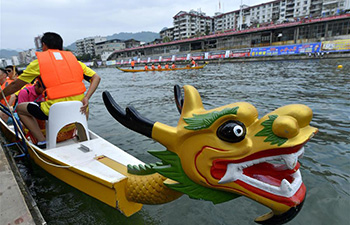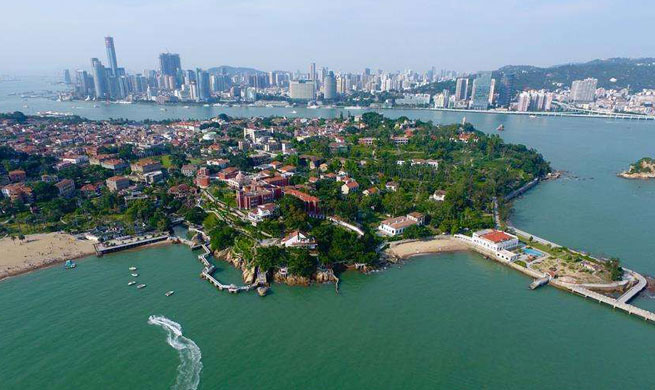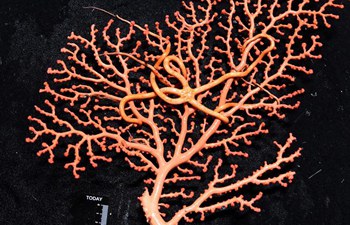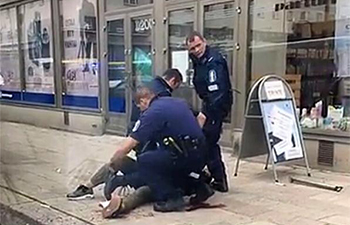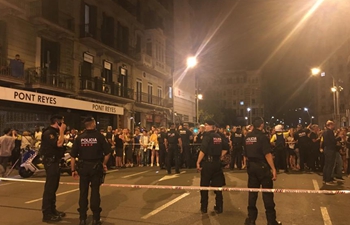by Tao Jun, Dong Hua
HO CHI MINH CITY, Aug. 29 (Xinhua) -- According to many producers and traders in Vietnam, people burn around 50,000 tons of votive paper objects worth many millions of U.S. dollars each year.
As the Ghost Festival is nearing, more and more real money is being "burnt."
The Dong Ho village in the Bac Ninh province, located around 35 km northeast of the capital city of Hanoi, is the busiest during Tet (Lunar New Year Festival) and the Hungry Ghost Festival, which is also known as the Yulan or Zhongyuan Festival.
The festival falls on the 15th day of July according to the lunar month (in early September 2017) and it is a day for people to pay their respects to the deceased by offering sacrifices.
The festival is a traditional Buddhist and Taoist event held in a number of Asian countries. Activities during the festival often include preparing ritualistic food offerings, burning incense, and burning joss paper, offering papier-mache items, gold and other fine goods for the visiting spirits of people's ancestors.
In Dong Ho, during Tet or the Hungry Ghost Festival, some 90 percent of families there work very hard, producing the village's main source of income, which is votive paper objects.
These paper objects symbolize real objects such as banknotes, gold ingots, clothes, shoes, boats, horses, and even villas, cars and smartphones, and are burnt as offerings to ancestral spirits.
"My family has made votive paper objects over the past two years. Most of the products are sold for the Hungry Ghost Festival. As the festival is approaching, our sales are increasing," Minh Tu, a local middle-aged woman in the village's Dao Tu hamlet, told Xinhua on Monday.
Along every road within the village, votive paper objects are piled up. Another local middle-aged woman who is the owner of a production base, said, "The best-selling items before the 15th day of July according to the lunar month include costumes and means of transport such as horses, motorbikes and cars."
Some buyers prefer modern items such as smartphones and cameras. Usually, each paper item costs from 20,000 Vietnamese dong (0.9 U.S. dollars) to 200,000 Vietnamese dong (9 U.S. dollars).
As for banknotes, the production base churns out 0.2 tons of the votive objects a day, she noted.
A young man who works at the Nghinh Viet production base, said, "This production base specializes in making paper dragon boats. The wholesales price is around 20,000 Vietnamese dong, but end-users may have to pay 40,000-50,000 Vietnamese dong for the boats."
Meanwhile, a girl working for the Quang Lan production base said that the base mainly produces about 300 pairs of shoes a day with a wholesales price of 1,000 Vietnamese dong per pair.
Colorful paper, cartons and bamboo splints can be seen in almost every household in the village and roads are crowded with vans setting off to deliver votive paper objects throughout the North.
Nguyen Van Tuan, vice chairman of Song Ho People's Committee, said that not only the commune, but also Dai Dong Thanh commune and Ho town in Thuan Thanh district have also focused on producing votive paper objects in recent years.
But Dong Ho prints, the village's traditional specialty, from which Dong Ho village makes its name, runs the risk of disappearing, with few families now committed to the unique craft dating back to the 16th century.
"The printed pictures produced in Dong Ho began to deteriorate in quality while I was growing up. At that time, we hardly received any orders or contracts. The images produced were dull and unpopular among those outside the village. Villagers began to abandon the work, and carvings and wooden printing blocks were left unattended or were lost," said Nguyen Dang Che, one of the oldest craftsmen, now in his 80s.
Che's 10,000-square-meter building is totally devoted to his family's project which is dedicated to maintaining and developing Dong Ho prints, with space for production and display, as well as accommodation for guests.
Che said he has revived over 100 types of Dong Ho prints and still has some 150 printed pictures to be restored. The old craftsman spent decades collecting hundreds of old wooden print blocks in his locality, while creating new wood blocks and colors, to develop the various looks of the prints.
Like Che's family, Nguyen Huu Sam, aged over 80, and his children, have not turned to producing votive paper objects to make a living.
They have chosen to continue with the ancient, unique craft and devote themselves to the production of Dong Ho prints.
His family's house, full of Dong Ho prints with different themes such as historical events, blessings, religious depictions and scenes from daily life, is far from the main roads in the village, but frequently visited by groups of tourists and collectors.
His son, Nguyen Huu Qua, owns a big picture production base and manages a club which is involved in training, making and selling Dong Ho prints. "Now we not only survive but even live quite comfortably, thanks to Dong Ho prints," Sam said.
Qua said Dong Ho prints are unique even when compared to other kinds of traditional paintings, as every step of the production of Dong Ho printing is done by hand.
The special "do" paper Dong Ho pictures are printed on is made from the bark of the "do" tree (a relative of the daphne). It is then coated with a thin layer of ground seashell paste, which gives it a bright and glittering look under sunlight.
The colors that are used for painting are made from natural ingredients, mostly from leaves, flowers, and ground shells. For example, bamboo leaves for black, indigo leaves for green, copper rust for blue, pine resin for amber, and crushed egg shells mixed with paste for white.
Craftsmen apply the colors to the paper in turn, and the pages are left to dry until all five layers of ink have been applied via the wooden block prints.
Subjects depicted in the prints are usually scenes from daily life and include seasons of the year, and symbols of prosperity, good luck and fertility.
"Besides famous paintings such as "Teacher," "Catching Coconuts," "Yin-Yang Pigs" and "A Scene of Jealousy," we make pictures based on a variety of other themes, including influential figures, landscapes and religion, Qua said.
While Vietnam wants the United Nations Educational, Scientific and Cultural Organization (UNESCO) in the coming years to add Dong Ho picture printing to its list of Intangible Cultural Heritage in Need of Urgent Safeguarding, the place is becoming the country's biggest votive paper object-making hub.









